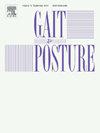移动能力强的人的步行和跑步:范围审查
IF 2.2
3区 医学
Q3 NEUROSCIENCES
引用次数: 0
摘要
结缔组织、骨骼肌和神经功能的损伤会导致全身性关节过动症(GJH)患者的步态功能障碍,导致终生活动受限。了解过度移动和非过度移动步态之间的差异可能会导致更有效的评估和治疗策略。本综述的目的是:1)综合和评估与运动能力强的人行走和跑步相关的证据,2)找出文献中的空白,3)为未来的研究提供方向。方法于2024年4月对6个电子数据库进行检索。2位审稿人对论文的合格性进行了评估,如果符合以下标准,则纳入论文:1)纳入全身性关节活动过度的人群,2)报告与步行或跑步步态相关的结果。研究质量评估使用修改版本的Downs和Black质量评估清单。结果共检索到3543篇论文。经过题目和摘要筛选,50篇论文被纳入终审稿。在质量评价方面,观察性论文从差到好,干预性论文从中等到好。步态分析报告的时空、运动学和动力学结果是最常见的,其次是与干预相关的功能测量和结果。由于研究的多样性阻碍了meta分析,因此进行了叙述性分析。结论:未见与超动跑步步态相关的文献。在步行研究中,纳入标准和结果测量的异质性限制了研究之间的可比性。在51篇论文中提出的众多具有统计学意义的结果中,临床相关性很少被报道,并且很难测量。本文章由计算机程序翻译,如有差异,请以英文原文为准。
Walking and running in people who are hypermobile: A scoping review
Objective
Impairments in connective tissue, skeletal muscle and neurological function contribute to gait dysfunction in people with generalised joint hypermobility (GJH), leading to significant activity limitation across the lifespan. Understanding differences between hypermobile and non-hypermobile gait may lead to more effective assessment and treatment strategies. The objectives of this scoping review were: 1) To synthesise and appraise the evidence relating to walking and running in people who are hypermobile, 2) identify gaps in the literature, and 3) provide direction for future research.
Methods
A search of 6 electronic databases was conducted in April 2024. Papers were assessed for eligibility by 2 reviewers and were included if they met the following criteria: 1) Include a population with generalised joint hypermobility, and 2) report outcomes relating to walking or running gait. Study quality was assessed using a modified version of the Downs and Black quality appraisal checklist.
Results
The search revealed 3543 papers. Following title and abstract screening, 50 papers were included in the final review. On quality appraisal, observational papers rated from poor to good, while interventional papers rated from moderate to good. Studies of gait analysis reporting spatiotemporal, kinematic, and kinetic results were most common, followed by functional measures and outcomes relating to interventions. A narrative analysis was conducted as the diversity of the studies prevented meta-analysis.
Conclusion
No papers related to hypermobile running gait. In studies of walking, heterogeneity in inclusion criteria and outcome measures limited comparability between studies. Of the numerous statistically significant outcomes presented in the 51 papers, clinical relevance was rarely reported and was found to be difficult to measure.
求助全文
通过发布文献求助,成功后即可免费获取论文全文。
去求助
来源期刊

Gait & posture
医学-神经科学
CiteScore
4.70
自引率
12.50%
发文量
616
审稿时长
6 months
期刊介绍:
Gait & Posture is a vehicle for the publication of up-to-date basic and clinical research on all aspects of locomotion and balance.
The topics covered include: Techniques for the measurement of gait and posture, and the standardization of results presentation; Studies of normal and pathological gait; Treatment of gait and postural abnormalities; Biomechanical and theoretical approaches to gait and posture; Mathematical models of joint and muscle mechanics; Neurological and musculoskeletal function in gait and posture; The evolution of upright posture and bipedal locomotion; Adaptations of carrying loads, walking on uneven surfaces, climbing stairs etc; spinal biomechanics only if they are directly related to gait and/or posture and are of general interest to our readers; The effect of aging and development on gait and posture; Psychological and cultural aspects of gait; Patient education.
 求助内容:
求助内容: 应助结果提醒方式:
应助结果提醒方式:


